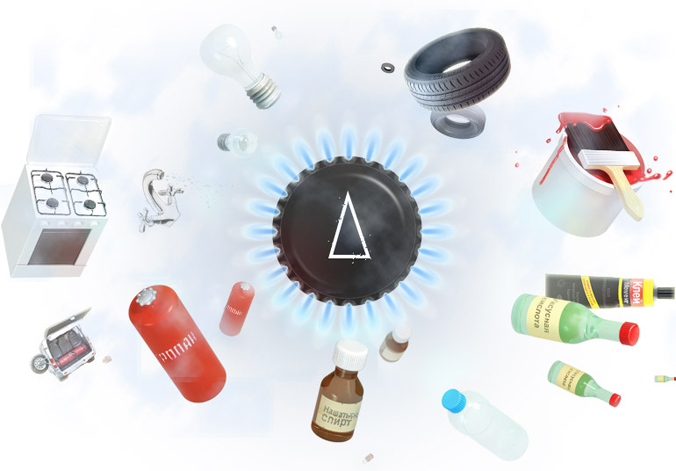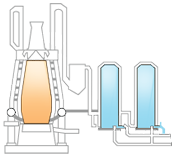Natural gas burns very well. Therefore, it is mostly used for generating electric or thermal energy. However, it can also be used to make fertilizers, fuel, paint, and many other items.


Significant volumes of gas are also used in the metallurgic industry. But here, natural gas is also used as an energy source for heating blast furnaces.
Green fuel
About one half of gas supplies in Russia fall on energy companies and public utilities. Even if there are no gas-powered stoves or water heaters in the house, electricity and hot water are most likely produced with the use of natural gas.
Natural gas is the most environmentally friendly hydrocarbon fossil fuel. Only water and carbon dioxide result from its combustion, while the combustion of oil products and coal results in soot and ash. In addition, the emission of the greenhouse carbon dioxide while the combustion of natural gas is the lowest, due to which it is called “green fuel”. Gas is the most popular fuel in the power industry of large cities for its high environmental performance.
It is possible to drive on gas
Natural gas can be used as a motor fuel. Compressed (or pressurized) methane costs half as much as petrol with the octane number of 76; extends the service life of engine; and can improve the urban ecology. Engine powered by natural gas complies with the Euro-4 environmental standard. Gas can be used for conventional vehicles, as well as for agricultural, water, air, and railway transport.
Compressed gas is produced at CNG filling stations by the compression of natural gas, supplied via the gas pipeline, to 20–25 MPa (200–250 atm).
Liquid motor fuels can also be produced from natural gas using the gas-to-liquid technology (GTL). Since natural gas is a quite inert product, it is first virtually always converted into a more reactive gas-vapor mixture, the so-called synthesis gas (mixture of CO and Н2).
Then, it is taken for synthesis to produce liquid fuel. This may be a so-called synthetic oil, diesel fuel, as well as lubricants and paraffins.
Liquid hydrocarbons were first produced from synthesis gas by German chemists Franz Fischer and Hans Tropsch in 1923. They used coal as a source of hydrogen at that time, though. Currently, different modifications of the Fischer-Tropsch method are applied in many marketed processes for conversion of gas into liquid hydrocarbons.
Gasoline separation
Primary gas processing takes place at GPP’s – gas processing plants.
Apart from methane, natural gas usually contains different admixtures which must be separated. These are nitrogen, carbon dioxide, hydrogen sulfide, helium, and water vapors.
Therefore, gas at GPP is primarily cleaned and dried. Gas is then compressed to a pressure required for processing. At gasoline extraction units, gas is separated into unstable natural gasoline and lean gas – a product, which is then pumped into gas trunklines. The same cleaned gas is supplied to chemical plants to make methanol and ammonia.
After separation from gas, unstable gasoline is supplied to gas fractionation units to extract light hydrocarbons such as: ethane, propane, butane, and pentane. These products also became a feedstock for further processing. For example, polymers and rubbers are subsequently produced from them. The propane-butane mixture is a finished product by itself – it is pumped into cylinders and used as a household fuel.
Paint, glue and vinegar
Methanol (CH3OH) is produced from natural gas under a scheme similar to the Fischer-Tropsch process. It is used as an agent for preventing hydrate plugs that are formed in pipelines at low temperatures. Methanol can also become a feedstock for manufacturing more complex chemical substances: formaldehyde, insulation materials, varnishes, paints, glues, fuel additives, and acetic acid.
Mineral fertilizers are produced from natural gas by means of several chemical conversions. At the first stage, it’s ammonia. The process of ammonia production is similar to the gas-to-liquid process, but different catalysts, pressure, and temperature are required.

Ammonia as such is a fertilizer; it is also used as a coolant in refrigerating units and as a feedstock for production of nitrogen compounds, such as nitric acid, ammonia nitrate, and carbamide.
How ammonia is produced
Natural gas is first cleaned from sulfur, and then mixed with heated water vapor and supplied to the reactor, where it passes through catalyst beds. This stage is called primary reforming or gas-vapor conversion. A gas mixture composed of hydrogen, methane, carbon dioxide (СО2), and carbon oxide (СО) exits from the reactor. Then, this mixture is sent to secondary reforming (gas-vapor conversion), where it is mixed with atmospheric oxygen, vapor, and nitrogen in proper proportions. At the next stage, CO and CO2 are removed from the mixture. Then, a mixture of hydrogen and nitrogen is sent to ammonia synthesis.

